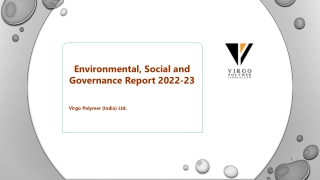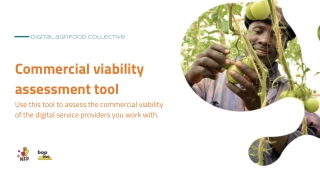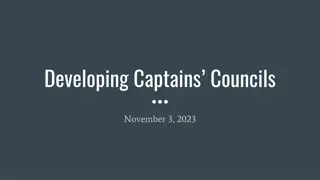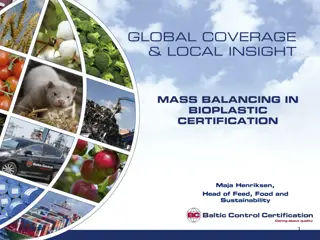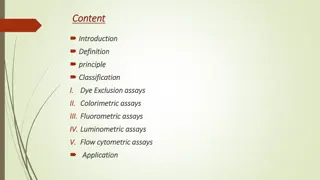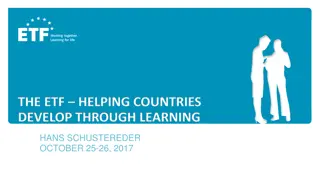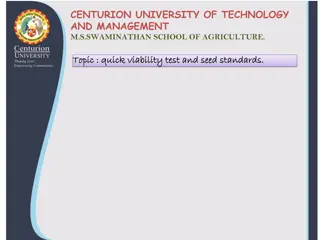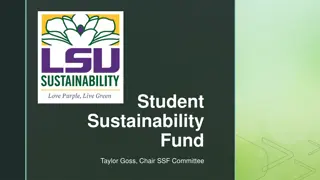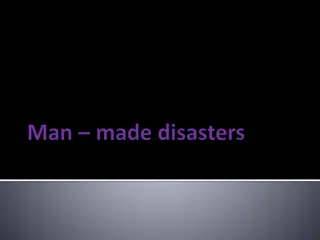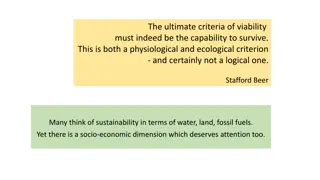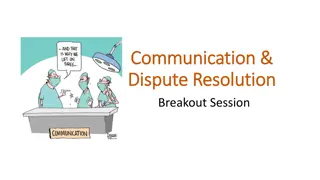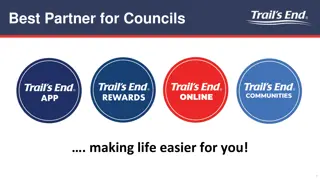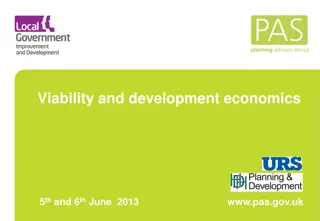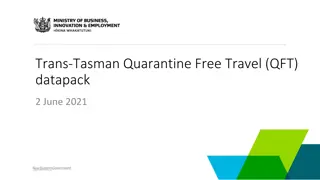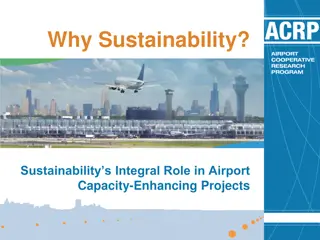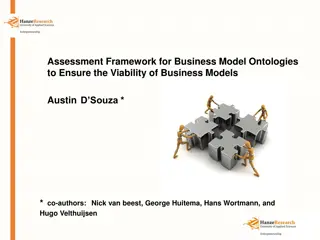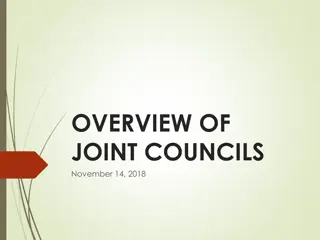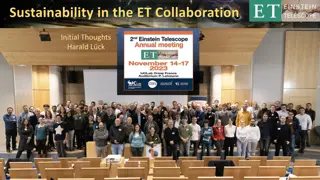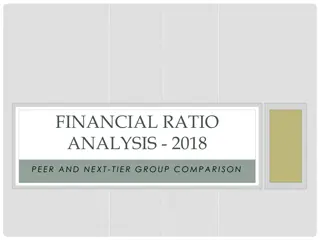Review of Sorell and Tasman Councils' Viability and Sustainability
KPMG conducted a feasibility study and councils consultation to review the terms of reference for reforming Sorell and Tasman Councils. The study identified four guiding principles for reform to benefit ratepayers and improve service levels, while maintaining local representation and strengthening financial status. Options include maintaining current structures, further shared services, and voluntary amalgamation. Public consultation and expert analysis were carried out to assess the councils' financial viability and potential for sustainability.
Download Presentation

Please find below an Image/Link to download the presentation.
The content on the website is provided AS IS for your information and personal use only. It may not be sold, licensed, or shared on other websites without obtaining consent from the author.If you encounter any issues during the download, it is possible that the publisher has removed the file from their server.
You are allowed to download the files provided on this website for personal or commercial use, subject to the condition that they are used lawfully. All files are the property of their respective owners.
The content on the website is provided AS IS for your information and personal use only. It may not be sold, licensed, or shared on other websites without obtaining consent from the author.
E N D
Presentation Transcript
Background KPMG South East Feasibility Study & Councils Consultation Sorell and Tasman Councils requested a Review Terms of Reference: Four Guiding Principles for Reform Be in the interests of ratepayers; Improve the level of service for communities; Preserve and maintain local representation; and Ensure that the financial status of the entities is strengthened. 1. 2. 3. 4.
The Boards Approach Scope of the Review Option 1. No change to Sorell and Tasman Councils Current Viability and Future Sustainability (10-20 year outlook) under the existing structure Option 2. Further shared services options Potential to improve sustainability through extended shared service arrangements Option 3. Voluntary Amalgamation of Sorell and Tasman Councils Potential to improve sustainability as a new amalgamated council
The Boards Approach (2) What is a sustainable council? capacity to meet the agreed service and infrastructure needs of their community and absorb foreseeable changes and unexpected shocks into the future - KPMG for LG Victoria a budget that is balanced over the medium to long term without the need for significant increases in rates and charges or cuts to services, while the burden is being shared fairly between current and future ratepayers - Crowe Horwath for LG Board 5 key areas for councils to demonstrate performance Financial sustainability Adequate service delivery Effective local representation Meeting regulatory obligations Managing municipal opportunities and challenges
Process for the Review Public consultation (24 February-6 April 2018): Over 50 written submissions (and a petition) Three public hearings in Hobart, Nubeena, and Sorell. Independent Expert Analysis (Crowe Horwath) Financial analysis and modelling Appraise the Feasibility Study s findings and modelling and the Councils LTFMPs Model long-term financial outlooks for both Councils and an amalgamated council Model potential to align Sorell and Tasman Councils rating policies under amalgamation option
Key Features of the Sorell And Tasman Councils and Municipal Areas Findings Sorell and Tasman have distinct demographic differences yet complementary economic and social interests Independent financial analysis shows both Sorell and Tasman Councils are not at imminent risk of being financially unviable But . Shared service arrangements are being used extensively to deliver financial efficiencies, with Tasman Council having a higher level of reliance on these arrangements; and The shared General Manager position between the Councils is critical to the success of these arrangements.
Option 1: Stand-alone Councils (No Change) Findings When standardised assumptions and realistic variations applied to LTFMPs - long-term sustainability is not as evident. The Board s analysis indicates approximately an additional $5 million for Sorell Council and $2 million for Tasman Council in rates revenue over the 20 year period would be required to remain sustainable. Tasman Council is viable in the short-term, largely as a result of the favourable shared services arrangements that it benefits from with Sorell Council.
Option 1: Stand-alone Councils (No Change) Shared services arrangement are highly vulnerable, risks include: key person dependencies; enduring support and increased demand in Sorell. If shared services unwound extra $3,500 per rateable property in Tasman (over 20 years) to maintain a sustainable council. May be beyond the capacity of Tasman ratepayers. Local representation under the stand-alone option would not change, BUT potential for improvements: introduction of community boards voice for local communities. Little scope for increased capacity, challenging the ability of both Councils to satisfactorily meet regulatory obligations and service demands.
Option 2: Further Shared Services Findings Limited viable options available to Sorell and Tasman Councils for further shared services in new service areas. marginal efficiencies at best. but could be better arrangements in place for the existing shared services if the Councils continue to stand alone. (As with Option 1) shared services are highly vulnerable.
Option 3: Voluntary Amalgamation Findings The combined entity is sustainable over the next two decades even with only very minor savings of $250,000 per annum. Would generate operating surpluses every year over the 20-year period. Would provide a benefit (compared to the stand-alone Councils) in the form of a reduction in the rating burden on Sorell and Tasman ratepayers: $11.3 million over 20 years; or $920 per rateable property or $660 per resident across the combined municipality.
Option 3: Voluntary Amalgamation Findings No scope for significant reduction in the existing aggregate staff levels. A works depot and service site would continue to be justified at Tasman (this was factored into the financial modelling). The introduction of (up to 3) electoral districts - complemented by community boards- would maintain local representation An amalgamated council is likely to: Demonstrate improved sustainability and resilience in the face of potential financial shocks but will still face some challenges. Deliver efficiencies (in internal transactional services and the removal of duplication between the two Councils) which would free up resources to be reallocated to customer services and regulatory obligations.
Option 3: Voluntary Amalgamation An amalgamated council is likely to allow for a greater strategic regional approach to planning and service delivery and provide outcomes that are likely to be greater than two stand-alone councils. The two Council have very different rating systems that would need to be integrated over time in an amalgamated council. Independent analysis, undertaken on behalf of the Board, indicates that a rating alignment over time is possible that would smooth the rating impacts on individual ratepayers.
Assessment Against Guiding Principles For Reform Material Benefit Neutral (Small Benefit/Detriment Material Detriment Stand-Alone Councils (Option 1) Further Shared Services (Option 2) Amalgamated Council (Option 3) Guiding Principles 1. Be in the interests of ratepayers Short-Term Long-term 2. Improve the level of service for communities Short-Term Long-term 3. Preserve and maintain local representation Short and Long-Term Short-Term 4. Ensure that the financial status of the entities is strengthened Long-term
RECOMMENDATIONS Recommendation 1 The Sorell and Tasman Councils be voluntarily amalgamated into a new council which incorporates the existing municipal boundaries (Option 3). Recommendation 2 The transitional process as outlined in the supporting recommendations for Option 3 be implemented, including that: The number of councillors of the new amalgamated council be 9. That (up to 3) electoral districts be created as a transitional measure for up to two local government terms. Electoral districts be based around either the areas of: Tasman Municipality (and adjacent areas of Sorell); Rural Sorell and Southern Beaches; and Sorell and Midway Point; or (If only two electoral districts are preferred) the former Sorell and Tasman municipal areas.
RECOMMENDATIONS Recommendation 2 (continued) An Interim Council be appointed for a period of up to 12 months and comprise either: 3 Commissioners ; with one an independent Chairperson; and with a member drawn from each of the affected municipal areas of Tasman and Sorell. (Option A); or 5 members; with an independent Chairperson; the two Mayors of the existing Councils; and a councillor nominated by each of the existing Councils. (Option B). Current Councillors be appointed to act in the role of Interim Community Board for the transition period until the election no later than October 2019, to conduct community consultation on the establishment of community boards in the new Council area post-transition. The General Manager continues on in the role as the General Manager until the expiry of his contract, at which time the new council could appoint its preferred General Manager. An amalgamated council be given the interim name of the Sorell-Tasman Council .
RECOMMENDATIONS Recommendation 3 The State Government considers providing transitional assistance to support the Interim Council and staff to bring the operations of the existing Councils together.


